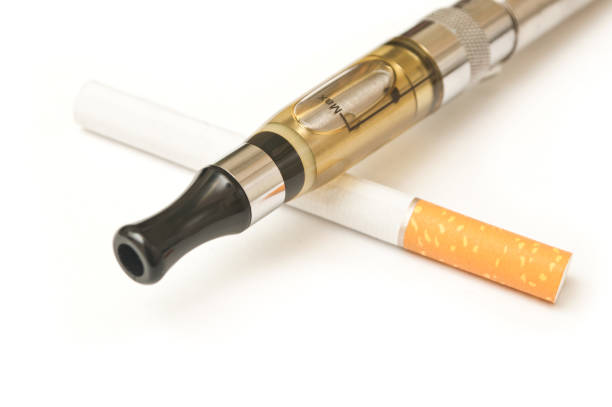The world of nicotine consumption has been transformed with the introduction of e-cigarettes, challenging the long-standing tradition of smoking conventional cigarettes. Although both methods deliver the addictive component found in tobacco, their composition, health impact, and delivery method vary significantly.
In this article, we explore the ongoing debate between e-cigarettes and traditional cigarettes, scrutinizing the health consequences of each and their long-term effects using simple terms and concepts.
A Simple Explanation of Vaping
Old-fashioned cigarettes involve burning dried tobacco leaves, enabling smokers to breathe in nicotine and other harmful substances. This technique has been utilized for many years to enjoy nicotine’s subtle, mood-boosting effects.
On the other hand, vaping is an advanced, cutting-edge method that uses an electronic gadget (such as an e-cigarette, e-pipe, or hookah pen) and a unique liquid containing nicotine, flavorings, and other chemicals.
When a person inhales from the vaping device, an electronic heat source turns the liquid into vapor, which can then be inhaled. Unlike traditional cigarettes, vaping doesn’t produce tar, particulate matter, or other dangerous byproducts of tobacco combustion.
Revolutionizing the Way We Enjoy Nicotine
Vaping has revolutionizing the way we enjoy nicotine, offering a modern and innovative alternative to traditional cigarette smoking. This transformation is largely due to the advanced technology used in vaping devices and the variety of flavors available, providing users with a new and unique experience. The customizable nature of vaping devices, coupled with the perception of a cleaner and more socially acceptable method of nicotine consumption, has contributed to the growing popularity of e-cigarettes.
Health Advantages of Vaping over Smoking
Recent research implies that vaping may be notably less hazardous than smoking over time, with vapers showing lower levels of toxins and cancer-causing agents in their bodies than smokers. Consequently, some experts promote vaping as a better alternative to smoking. It is vital, however, to realize that while vaping is less harmful than smoking, it is not entirely without risks.
Health Effects of Smoking and Vaping: A Simple Comparison
The adverse health effects of smoking are widely recognized and include the following:
- Heart-related issues, such as high blood pressure, clotting, coronary heart disease, and stroke
- Breathing problems like asthma and COPD
- Various cancers affecting different organs and parts of the body
- Pregnancy complications, including early delivery, stillbirth, low birth weight, sudden infant death syndrome, and facial clefts in newborns
- Additional concerns, such as weaker bones, tooth loss, increased risk for cataracts, muscular degeneration, diabetes, reduced immune function, and rheumatoid arthritis
Since vaping is a relatively recent development, its adverse health effects haven’t been researched as thoroughly. Nevertheless, there are some known dangers associated with vaping.
- For example, excessive nicotine can be harmful, and vaping liquid can cause deadly nicotine poisoning in children, even upon skin contact.
- Also, the non-nicotine chemicals in vaping liquids may be hazardous, with formaldehyde and acrolein being primary concerns. These dangerous compounds might be produced when the liquid is turned into vapor.
- Moreover, some flavorings used in vaping liquids contain chemical agents known for their cancer-causing properties.
The Popularity of Vaping
The Appeal of E-Cigarettes
E-cigarettes have grown in popularity for various reasons. They often come in sleek, modern designs, such as the pod vape box set, and offer a range of enticing flavors. Many consider vaping a “cleaner” and more socially acceptable alternative to traditional cigarettes. Additionally, vaping devices can be easily customized to suit individual preferences, adding to their appeal.
The Role of Marketing
The marketing strategies employed by e-cigarette companies have also contributed to the popularity of vaping. These companies often target younger demographics with attractive packaging and appealing flavors. Furthermore, e-cigarettes are often promoted as a healthier alternative to traditional cigarettes, despite their uncertain long-term health effects.
Making an Informed Decision
Weighing the Pros and Cons
Before switching from traditional cigarettes to e-cigarettes, weighing both methods’ advantages and disadvantages is crucial. While vaping may be less harmful than smoking, it has risks. Understanding the potential health implications of both choices is essential before deciding.
Consult a Healthcare Professional
Consulting with a healthcare professional is always a good idea if you are considering changing your nicotine consumption habits. They can provide personalized guidance on the best course of action based on your unique circumstances and medical history. They may also recommend additional resources or support programs to assist you in your journey toward better health.
Conclusion
As more research is conducted in the future, a clearer understanding of vaping’s exact health risks will likely emerge. However, it is already clear that vaping is not a healthy habit, even [if it is less harmful than smoking traditional cigarettes.
While e-cigarettes may offer a less dangerous alternative for smokers looking to quit or reduce their tobacco intake, it is essential to carefully consider the risks and benefits before making the transition.
The debate between e-cigarettes and traditional cigarettes is ongoing, and as more research is conducted, our understanding of the health risks associated with vaping will likely evolve. While e-cigarettes may provide a less harmful alternative for those looking to quit or reduce their tobacco use, it is crucial to make an informed decision by weighing the risks and benefits and seeking advice from a healthcare professional.


